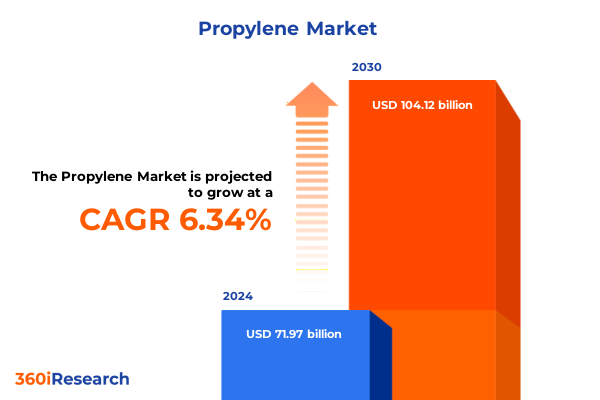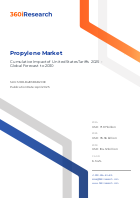The Propylene Market size was estimated at USD 71.97 billion in 2024 and expected to reach USD 76.36 billion in 2025, at a CAGR 6.34% to reach USD 104.12 billion by 2030.

Introduction to the Evolving Propylene Landscape
The propylene market stands at a pivotal crossroads, driven by rapid shifts in production technologies, evolving end-use landscapes, and mounting trade pressures. As a critical building block for a diverse array of chemical and polymer products, propylene’s significance spans beyond commodity status to a strategic raw material underpinning global manufacturing and innovation. This introduction sets the stage for an in-depth examination of the forces redefining supply chains, competitive dynamics, and investment priorities within the propylene ecosystem.
Through a structured analysis, this executive summary unpacks the transformative trends reshaping feedstock availability and cost structures, assesses the cumulative effects of new tariff regimes, and delivers segmented insights across purity grades, production pathways, end-use applications, and distribution channels. By weaving together regional and company-level perspectives, the narrative equips decision-makers with the clarity needed to navigate complexity, anticipate challenges, and capitalize on emerging opportunities. With a focus on actionable guidance and strategic alignment, this section lays the groundwork for a comprehensive exploration of the current and future propylene landscape.
Transformative Shifts in the Propylene Market Landscape
The propylene sector is undergoing transformative shifts driven by innovation, regulatory developments, and shifting consumer demands. Advanced dehydrogenation technologies are expanding capacity, while integrated petrochemical complexes are pursuing feedstock flexibility to mitigate volatile crude oil pricing. Concurrently, the rise of circular economy principles is spurring investments in chemical recycling, creating alternative propylene streams sourced from post-consumer plastics.
Environmental regulations are compelling producers to reduce carbon intensity, leading to the adoption of low-emission production processes and the integration of renewable hydrogen. This convergence of technology and sustainability is catalyzing collaborations between traditional petrochemical players and cleantech innovators, fostering new joint ventures targeting bio-based propylene and green hydrogen integration.
On the demand side, lightweighting in automotive and packaging industries, coupled with the surge in medical equipment production, is elevating propylene derivatives. The digitalization of supply chains enhances transparency and operational efficiency, while data-driven analytics optimize plant performance and logistics. These transformative currents underscore a market in flux, where agility and strategic foresight determine competitive advantage.
Cumulative Impact of United States Tariffs 2025 on Supply Chains
The introduction of enhanced tariffs by the United States in 2025 has reverberated throughout the global propylene supply chain. Imported volumes from key exporting regions now face elevated duties, prompting buyers to retool sourcing strategies and accelerate contract renegotiations. Domestic producers have leveraged this protective measure to reinforce local capacity expansions, yet the higher cost base has translated into tighter margins for end-users reliant on imported stocks.
In response, trading houses have diversified their portfolio, linking with suppliers in regions exempt from or less impacted by the tariff schedule. This dynamic has intensified competition among exporters seeking preferential trade agreements and bolstered investments in local warehousing and blending facilities to circumvent border tariffs. As a result, regional supply hubs are gaining prominence, and logistical reconfigurations are reshaping inventory management practices.
Moreover, end-use industries are recalibrating their cost structures by optimizing propylene consumption through process intensification and material substitution. The tariff regime has highlighted the strategic importance of integrated production-to-distribution platforms, reinforcing the value of domestic feedstock security and just-in-time delivery models.
Key Segmentation Insights Across Purity, Process, Application, Industry, and Distribution
A granular view across product purity levels reveals distinct value propositions and margins: catalyst-sensitive applications prioritize polymer grade feedstock, while refinery grade remains the workhorse for petrochemical intermediates. Fluid catalytic cracking continues to dominate conventional process volumes, yet propane dehydrogenation is capturing share due to its selective yield and lower byproduct intensity. Meanwhile, steam cracking retains relevance for integrated complexes co-producing ethylene.
Diverse applications drive demand heterogeneity: acrolein and acrylic acid production hinges on high-purity streams, whereas polypropylene and isopropyl alcohol sectors absorb polymer-grade propylene. Oxo alcohols and acrylic monomers exhibit strong links to performance materials, while acrylonitrile and cumene reflect cyclical petrochemical investments. In packaging and plastics segments, polypropylene resonates with lightweighting and recyclability imperatives, reinforcing propylene’s centrality to circular design.
End-user industries further stratify market dynamics; automotive manufacturers deploying exterior and interior components demand stringent consistency, while building and construction players source both exterior and interior materials with variable performance criteria. Chemicals and petrochemicals chain participants differentiate between base chemical and intermediate chemical feedstocks, and electronics producers require specialized grades for accessories and devices alike. In medical and healthcare, both medical equipment and pharmaceutical applications underscore purity and reliability. Textile and apparel brands integrate propylene-based fibers across apparel, home textiles, and industrial textiles. Distribution channels balance offline direct sales, distributors and traders with online portals, encompassing company-owned and third-party websites to meet evolving procurement preferences.
This comprehensive research report categorizes the Propylene market into clearly defined segments, providing a detailed analysis of emerging trends and precise revenue forecasts to support strategic decision-making.
- Purity
- Production Process
- Application
- End User Industry
- Distribution Channel
Key Regional Insights Highlighting Americas, EMEA, and Asia-Pacific Dynamics
Regional markets present stark contrasts in regulatory frameworks, feedstock accessibility, and demand drivers. In the Americas, shale-gas derived propane dehydrogenation projects have unlocked cost-competitive propylene, reinforcing North America as a net exporter and spurring downstream capacity. Latin America’s refining constraints create pockets of opportunity for imports, especially for chemical manufacturers seeking reliable polymer grade streams.
Europe, the Middle East & Africa region faces feedstock volatility, with varying degrees of integration between refining and petrochemical sectors. Gulf producers leverage advantaged ethane and butane resources to feed steam crackers and PDH units, augmenting export flows to Europe. Stringent environmental standards across the bloc drive investments in carbon capture and process electrification, while Africa’s nascent chemical industries gradually scale polypropylene capacity to serve domestic markets.
In Asia-Pacific, rapid industrialization and urbanization fuel broad-based demand. China’s expansive petrochemical complexes integrate FCC and steam cracking, absorbing refinery grade propylene across acrylic, oxo-alcohol, and polypropylene chains. India’s refinery expansions and PDH ventures are enhancing self-sufficiency, and Southeast Asian hubs are emerging as blending and distribution centers to supply regional consumers and global export markets.
This comprehensive research report examines key regions that drive the evolution of the Propylene market, offering deep insights into regional trends, growth factors, and industry developments that are influencing market performance.
- Americas
- Asia-Pacific
- Europe, Middle East & Africa
Key Companies Shaping Competitive and Innovative Dynamics
The competitive arena features a mix of global giants and agile regional players. Integrated leaders such as BASF SE, The Dow Chemical Company, and LyondellBasell Industries Holdings B.V. leverage scale and R&D capabilities to innovate process efficiencies and specialty derivatives. National oil companies including Bharat Petroleum Corporation Limited, Hindustan Petroleum Corporation Limited, Indian Oil Corporation Limited, PetroChina Company Limited, and PETRONAS Chemicals Group Berhad underpin regional supply security through upstream integration.
Specialized producers like Borealis AG, Braskem S.A., NOVA Chemicals Corporation, and Borealis affiliate Consortiums have embraced circular feedstock initiatives, piloting chemical recycling and bio-propylene projects. Chevron Phillips Chemical Company LLC and Saudi Basic Industries Corporation combine PDH expertise with expansive distribution networks, while INEOS AG and Lotte Chemical operate flexible cracking assets that toggle between naphtha and LPG feedstocks.
Value chain innovators such as LG Chem, Ltd., Mitsui Chemicals, Inc., and Sumitomo Corporation differentiate through downstream functional polymers, while SINOPEC Shanghai Petrochemical Co., Ltd. and ORLEN S.A. focus on regional integration to capture export flows. Dehon Service SAS – CLIMALIFE, PTT Global Chemical Public Company Limited, Repsol, S.A., Merck KGaA, and Vizag Chemical International round out a diverse supplier base distinguished by specialty grades, regional market access, and service models.
This comprehensive research report delivers an in-depth overview of the principal market players in the Propylene market, evaluating their market share, strategic initiatives, and competitive positioning to illuminate the factors shaping the competitive landscape.
- BASF SE
- Bharat Petroleum Corporation Limited
- Borealis AG
- Braskem S.A.
- Chevron Phillips Chemical Company LLC
- Dehon Service SAS – CLIMALIFE
- Hindustan Petroleum Corporation Limited
- Indian Oil Corporation Limited
- INEOS AG
- LG Chem, Ltd.
- Lotte Chemical
- LyondellBasell Industries Holdings B.V.
- Merck KGaA
- Mitsui Chemicals, Inc.
- NOVA Chemicals Corporation
- ORLEN S.A.
- PetroChina Company Limited
- PETRONAS Chemicals Group Berhad
- PTT Global Chemical Public Company Limited
- Repsol, S.A.
- Saudi Basic Industries Corporation
- SINOPEC Shanghai Petrochemical Co., Ltd.
- Sumitomo Corporation
- The Dow Chemical Company
- Vizag Chemical International
Actionable Recommendations for Industry Leaders to Enhance Resilience
Industry leaders should prioritize strategic feedstock diversification by investing in flexible PDH and steam cracking capacities, thereby mitigating feedstock volatility and tariff impacts. Aligning with cleantech partners to scale chemical recycling initiatives and bio-based propylene pathways will bolster sustainability credentials and secure alternative supply streams.
Enhancing digital integration across the supply chain—from predictive maintenance to demand forecasting—will optimize asset utilization and minimize operational disruptions. Establishing regional distribution hubs and local blending terminals can circumvent trade barriers and reduce lead times for critical end-users.
Engaging in collaborative research consortia can accelerate low-carbon process development, while joint ventures with downstream converters can create tailored propylene derivatives for high-growth applications in medical, automotive, and electronics sectors. Finally, implementing robust scenario-planning frameworks will equip organizations to navigate evolving tariff landscapes and regulatory requirements with agility.
Explore AI-driven insights for the Propylene market with ResearchAI on our online platform, providing deeper, data-backed market analysis.
Ask ResearchAI anything
World's First Innovative Al for Market Research
Conclusion: Navigating Opportunity and Complexity in the Propylene Sector
The propylene market’s trajectory is defined by the interplay of technological advances, policy frameworks, and shifting demand patterns. Producers that embrace feedstock flexibility, decarbonization strategies, and digital transformation will navigate trade headwinds and maintain competitive positioning. On the demand side, converters that optimize propylene utilization, engage in co-development with suppliers, and invest in circularity will secure cost-effective and sustainable inputs.
By synthesizing segmentation, regional, and competitive insights, stakeholders can make informed strategic decisions that align capital expenditure with market realities and long-term sustainability goals. The industry’s evolution underscores the need for continuous innovation, proactive collaboration, and adaptive risk management to thrive in a dynamic landscape.
This section provides a structured overview of the report, outlining key chapters and topics covered for easy reference in our Propylene market comprehensive research report.
- Preface
- Research Methodology
- Executive Summary
- Market Overview
- Market Insights
- Cumulative Impact of United States Tariffs 2025
- Propylene Market, by Purity
- Propylene Market, by Production Process
- Propylene Market, by Application
- Propylene Market, by End User Industry
- Propylene Market, by Distribution Channel
- Americas Propylene Market
- Asia-Pacific Propylene Market
- Europe, Middle East & Africa Propylene Market
- Competitive Landscape
- ResearchAI
- ResearchStatistics
- ResearchContacts
- ResearchArticles
- Appendix
- List of Figures [Total: 26]
- List of Tables [Total: 600 ]
Call-To-Action: Engage with Ketan Rohom for the Full Propylene Market Report
To acquire the full market research report and gain deeper strategic intelligence, please contact Ketan Rohom, Associate Director, Sales & Marketing. He will provide tailored access to the comprehensive data, in-depth analysis, and custom advisory support necessary to inform your investment and operational strategies.

- How big is the Propylene Market?
- What is the Propylene Market growth?
- When do I get the report?
- In what format does this report get delivered to me?
- How long has 360iResearch been around?
- What if I have a question about your reports?
- Can I share this report with my team?
- Can I use your research in my presentation?




